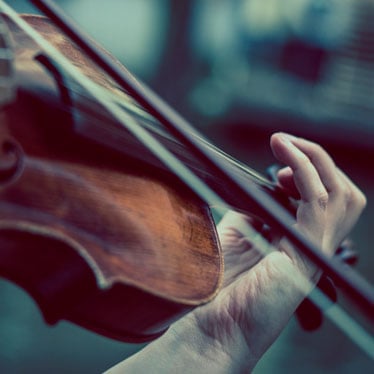How Your Violin Produces Sound

The violin produces such beloved tones and has such incredible harmonic properties that its well-known sound is celebrated all over the globe. Easily lending itself to a number of different genres of music, its worldwide popularity makes it a wonderful instrument to learn to play. But, have you ever considered how your violin actually makes the sounds you hear? Learning the physics of a string instrument like the violin is really cool, because the quality of the sound you’re able to produce depends on a number of factors working together in perfect synchrony.
Sound waves happen when there is a vibration. The air around the vibrating object is effected by its motion, compressing the air molecules and moving them forward and then allowing a space for the air to retract (called, rarefactions). These “oscillations” can be heard at certain levels by humans because they occur on frequencies that our ears can interpret.
Without getting too technical, the following information explains how your violin makes the sound you hear. And, knowing these basics can help you recognize and understand the importance of having a quality built violin and a professional set-up.
Fundamental Facts (Don’t worry, they’re not brain numbingly boring)
Hertz (Hz) is a measurement of cycles per second, and is used to measure a variety of waves, including sound. The violin is brilliantly engineered to create sound waves between 1 and 4 kHz (kilohertz), which is the level where human ears are most sensitive.
Frequency determines the pitch of the sound. Higher frequency, higher pitch. Essentially, the frequency is equal to the number of “cycles” of vibration, divided by the length of time, which is measured in hertz. Each specific frequency corresponds to an exact pitch. For example, the note “A” on the treble clef, above middle C, is measured at 440 vibrations per second (Hz).
Learn more about pitch and frequency at the physics classroom.
Important Variables that Influence the Amplitude and Frequency
There are certain factors that influence sound production on a string instrument. Each item plays a key role in how your violin makes its unique sound.
Strings—your strings form the foundational vibrating object on your violin, and as such, are an integral part of sound production. The length, mass, and tension of each violin string effects its ability to deliver a certain pitch.
- Thicker strings (with more mass) vibrate at a slower rate than thinner ones, and are used accordingly. For example, the A string on a violin is thinner than an A String on a cello, and your E string is thinner than your G string.
- Higher tension, like when you raise the pitch by increasing the “tightness” of a string, creates a higher pitch.
- The length of the string effects frequency. Shorter strings, like when you shorten the length form the tailpiece by applying your finger, have a higher pitch.
Bow—bowing and plucking initiates the vibration. Rosin helps the hair “grip” the string, which creates the oscillation needed. However, if the strings could make music by themselves, there’d be no need for a crafted instrument.
Bridge—the bridge of your instrument plays the most important role in the sound your instrument produces. The bridge is perfectly positioned to transfer the vibrating energy of the strings to the body of your violin, and the air it contains. Mutes are used to effect its ability, by creating more mass that hinders energy transference. Placement is key.
Soundpost and Bass Bar—These items are located directly beneath the feet of your bridge, and instrumental in sound production. The soundpost is a vertical, moveable object that connects the top and bottom plate on the treble side of the bridge (E-string). It prevents the tension of the strings from collapsing the belly (top plate), creates a pivot point, and channels the energy of the bridge to the belly and back plate of your violin. The bass bar is a longitudinal part that runs the length of the body, from the bass side of the bridge to the neck. This allows the energy from the bridge to transfer to a large area of the belly.
Body (top and bottom plates)—these are specially created to vibrate up and down, and the way they are crafted determines how well they resonate (keep vibrating to produce sound).
F-Holes—these allow a connection to the air outside with the air inside the body, and their length dictates how much the belly can move.
When all of these factors are working together correctly, the body of your instrument converts the vibrations into sound. Violin construction and a professional set-up ensures that all the factors are in the correct position. Violins are a work of art that can create art, and by knowing how your instrument produces sound, you can help keep it at its optimum playing condition.


